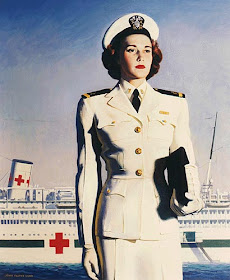 |
| Bought at Lisa Loot |
Thank you for all the pep and suggestions in yesterday's post. I feel slightly better about it now. There is another nice thing about the uniform- it actually fit me. Shirts are hard on me as I have a narrow back and shoulders, but not a very narrow front... So it was a nice surpise to find that it fitted quite well. several of you suggested jewelry, which I honestly hadn't thought about. I'm good at putting my clothes out the day before, but not not jewelry. Unfortunately I don't think I can wear pins and brooches and bangles drives me crazy, but nice earrings are an excellent option.
 |
| Bought at Majean Vintage |
Despite having a workmate insisting that I look like a horse when I wear them, I really like my hairnets from Arthelia's Attic. The black one would go well with the uniform, but a grey or a green one would do as well.
I also really like the quality of the hair flowers from Belle Blossoms. I have found that I rarely reach for the very large ones, and wearing one behind my ear just tickles, but smaller ones on a comb are quite useful. And they do have a lot of nice ones

 The combs are really excellent, usually such items just slip out of my hair, but these are called Grip-Truth and the stay were you put them. It is also possible to buy them plain and glue whatever decorations you want on them.
The combs are really excellent, usually such items just slip out of my hair, but these are called Grip-Truth and the stay were you put them. It is also possible to buy them plain and glue whatever decorations you want on them.
 |
| Aris Allen All Black 1940s Suede Sole Mary Jane Wingtip |
Dance Store has many nice shoes I want- I have mentioned them before. And I think any of these could be worn at work to perk up my day.
 |
| Aris Allen 1930s Black & Silver Faux Ostrich Heeled Oxford |
 |
| Aris Allen 1940s Black Faux Suede 3 Buckle Heeled |
I also have a huge collection of stockings. A couple of years ago I shopped at Calezza any time I felt for candy. Undoubtely good for my figure, but now I have two drawers fills with stockings and one of those are solely unopened! Partly because my taste have changed a bit. I used to go for patterend stocking, now I usually wear plain ones with back seams. With a plain black skirt I think I could use up my patterned ones. Most of my stockings are out of stock now, but here are a few examples from my stocking-wardrobe.
| Hair grips from the 40's or 50's. Bought at Vintage Curves |










WWII.JPG)












